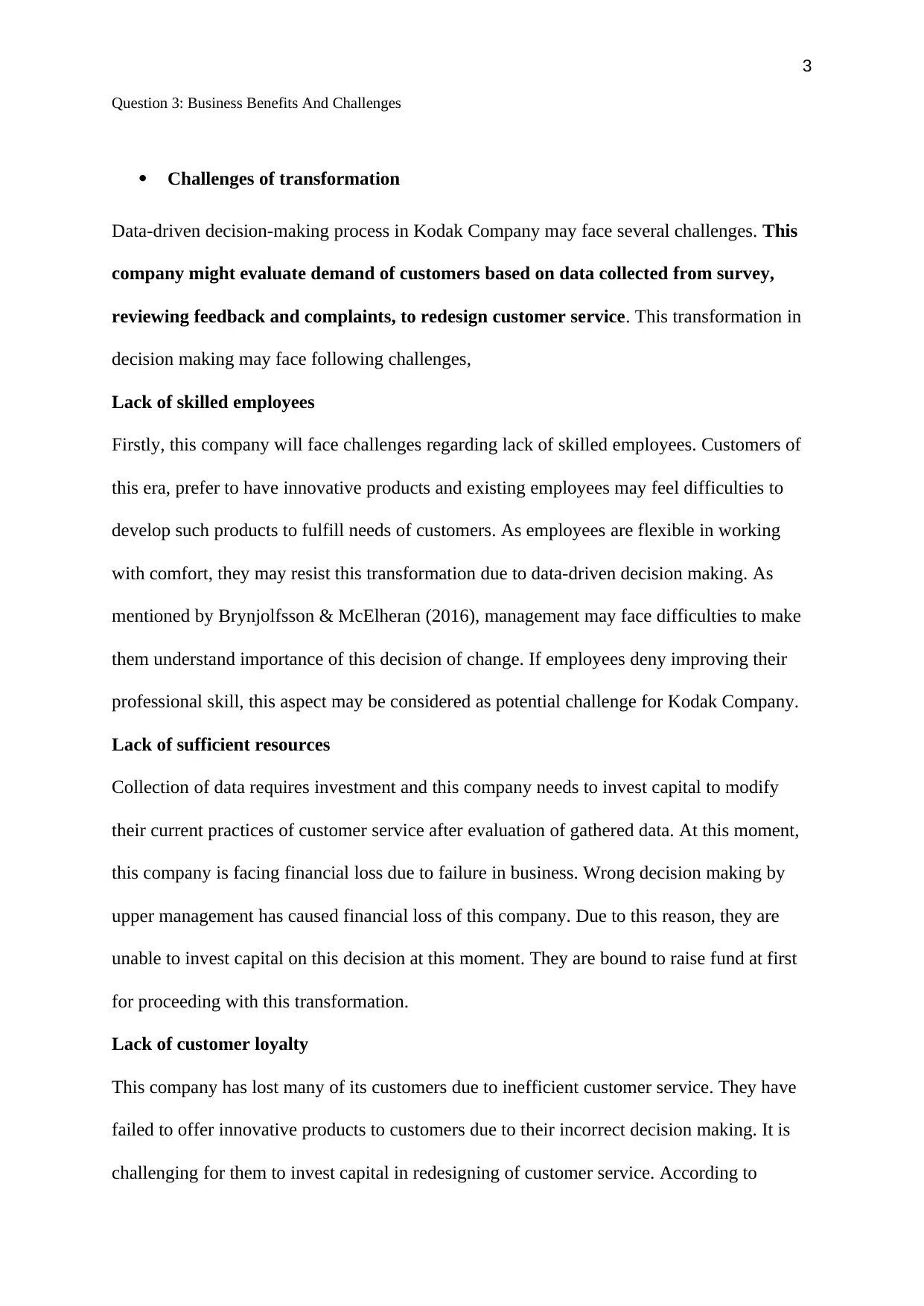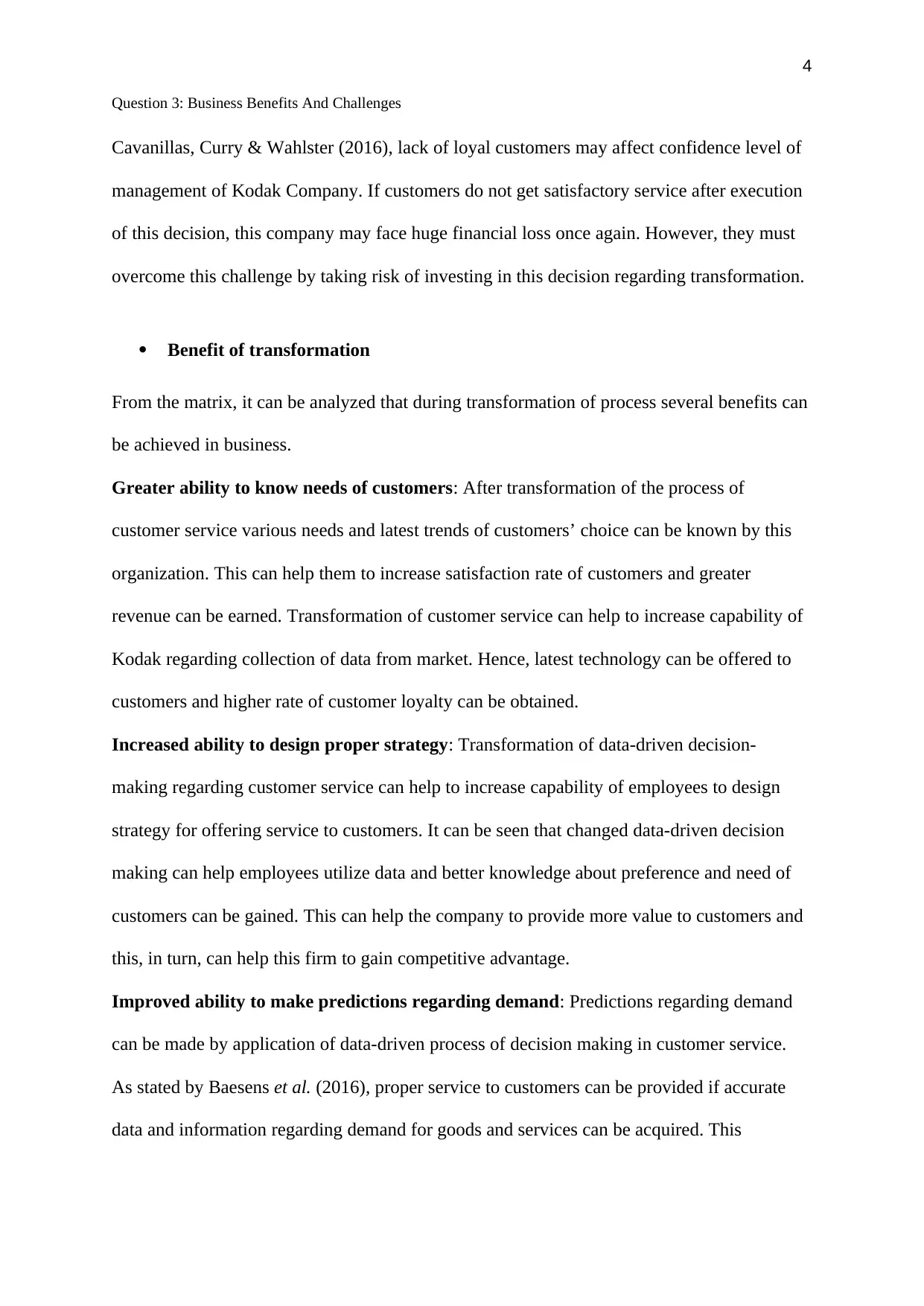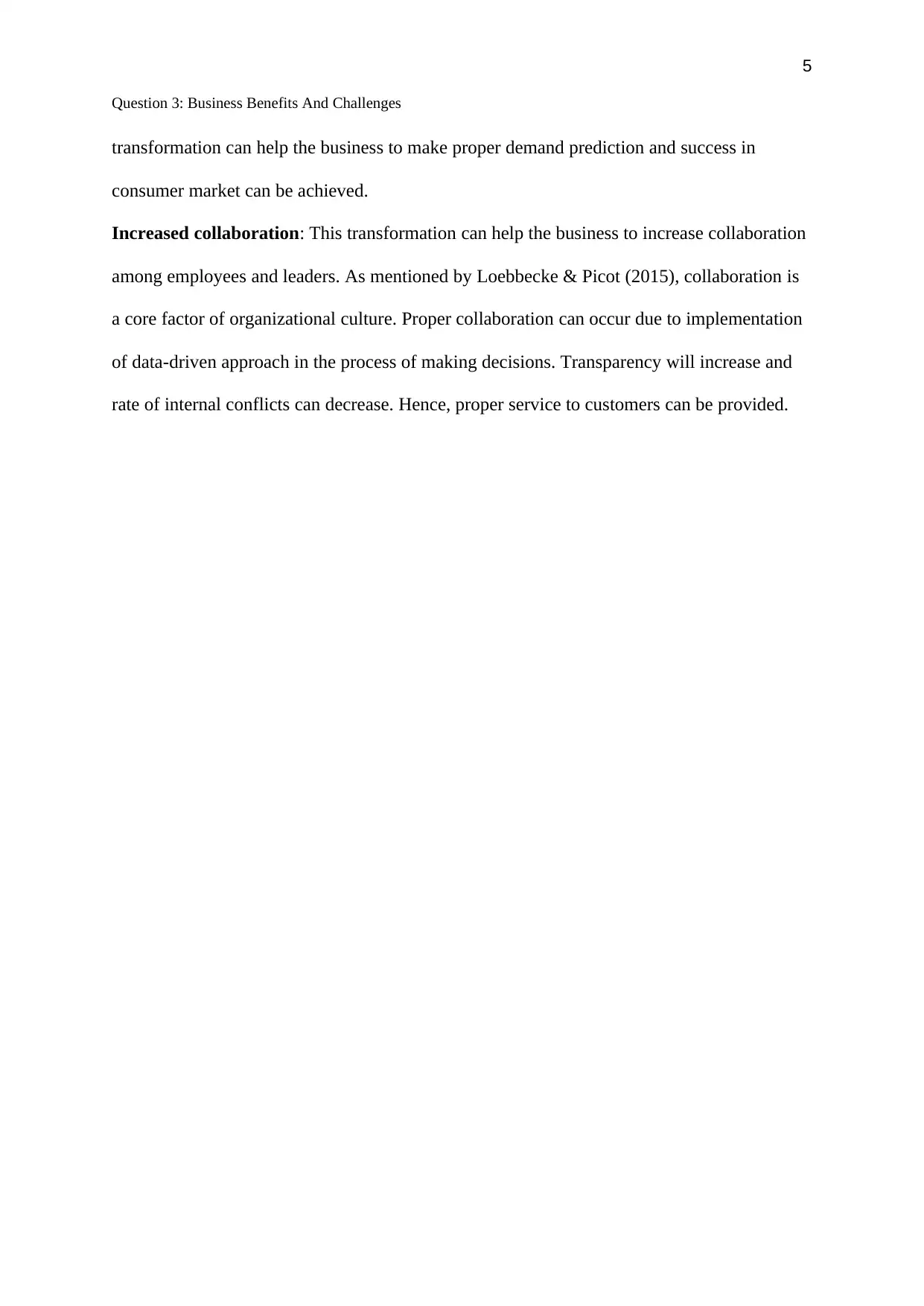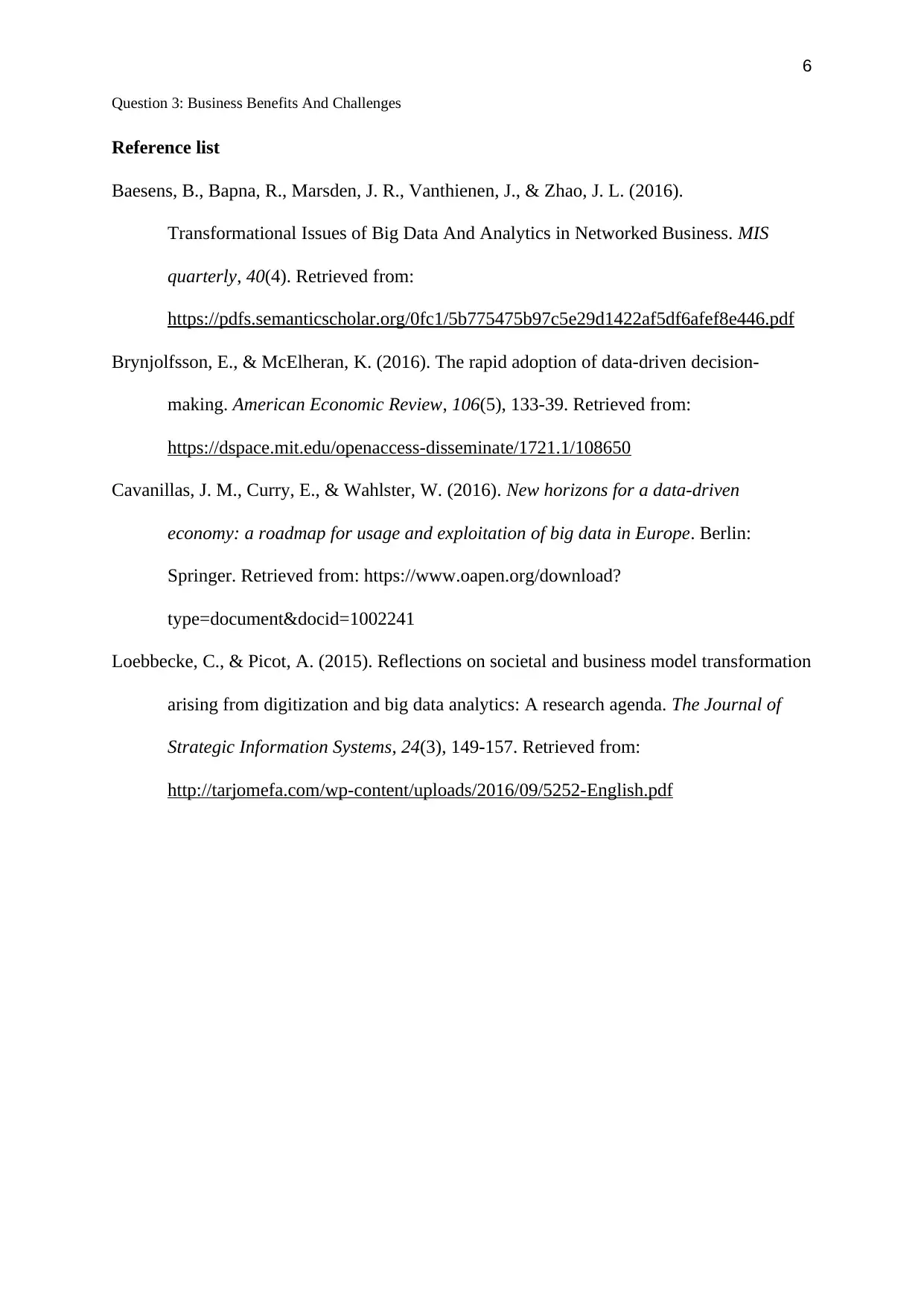Kodak Company: Business Benefits and Challenges of Transformation
VerifiedAdded on 2023/03/20
|6
|971
|68
Report
AI Summary
This report provides an analysis of the business benefits and challenges associated with Kodak's transformation, focusing on the implementation of a data-driven decision-making process. The report explores the challenges Kodak faces, such as the lack of skilled employees, insufficient resources, and potential loss of customer loyalty. It also examines the benefits of transformation, including a greater ability to understand customer needs, increased capability to design effective strategies, improved demand prediction, and enhanced collaboration among employees. The report highlights the importance of data-driven approaches in redesigning customer service, addressing financial losses, and gaining a competitive advantage in the market. Furthermore, it references several academic sources to support its findings.

Running Head: Question 3: Business Benefits And Challenges
QUESTION 3: BUSINESS BENEFITS AND CHALLENGES
QUESTION 3: BUSINESS BENEFITS AND CHALLENGES
Paraphrase This Document
Need a fresh take? Get an instant paraphrase of this document with our AI Paraphraser

2
Question 3: Business Benefits And Challenges
Table of Contents
Challenges of transformation.....................................................................................................3
Benefit of transformation...........................................................................................................4
Question 3: Business Benefits And Challenges
Table of Contents
Challenges of transformation.....................................................................................................3
Benefit of transformation...........................................................................................................4

3
Question 3: Business Benefits And Challenges
Challenges of transformation
Data-driven decision-making process in Kodak Company may face several challenges. This
company might evaluate demand of customers based on data collected from survey,
reviewing feedback and complaints, to redesign customer service. This transformation in
decision making may face following challenges,
Lack of skilled employees
Firstly, this company will face challenges regarding lack of skilled employees. Customers of
this era, prefer to have innovative products and existing employees may feel difficulties to
develop such products to fulfill needs of customers. As employees are flexible in working
with comfort, they may resist this transformation due to data-driven decision making. As
mentioned by Brynjolfsson & McElheran (2016), management may face difficulties to make
them understand importance of this decision of change. If employees deny improving their
professional skill, this aspect may be considered as potential challenge for Kodak Company.
Lack of sufficient resources
Collection of data requires investment and this company needs to invest capital to modify
their current practices of customer service after evaluation of gathered data. At this moment,
this company is facing financial loss due to failure in business. Wrong decision making by
upper management has caused financial loss of this company. Due to this reason, they are
unable to invest capital on this decision at this moment. They are bound to raise fund at first
for proceeding with this transformation.
Lack of customer loyalty
This company has lost many of its customers due to inefficient customer service. They have
failed to offer innovative products to customers due to their incorrect decision making. It is
challenging for them to invest capital in redesigning of customer service. According to
Question 3: Business Benefits And Challenges
Challenges of transformation
Data-driven decision-making process in Kodak Company may face several challenges. This
company might evaluate demand of customers based on data collected from survey,
reviewing feedback and complaints, to redesign customer service. This transformation in
decision making may face following challenges,
Lack of skilled employees
Firstly, this company will face challenges regarding lack of skilled employees. Customers of
this era, prefer to have innovative products and existing employees may feel difficulties to
develop such products to fulfill needs of customers. As employees are flexible in working
with comfort, they may resist this transformation due to data-driven decision making. As
mentioned by Brynjolfsson & McElheran (2016), management may face difficulties to make
them understand importance of this decision of change. If employees deny improving their
professional skill, this aspect may be considered as potential challenge for Kodak Company.
Lack of sufficient resources
Collection of data requires investment and this company needs to invest capital to modify
their current practices of customer service after evaluation of gathered data. At this moment,
this company is facing financial loss due to failure in business. Wrong decision making by
upper management has caused financial loss of this company. Due to this reason, they are
unable to invest capital on this decision at this moment. They are bound to raise fund at first
for proceeding with this transformation.
Lack of customer loyalty
This company has lost many of its customers due to inefficient customer service. They have
failed to offer innovative products to customers due to their incorrect decision making. It is
challenging for them to invest capital in redesigning of customer service. According to
⊘ This is a preview!⊘
Do you want full access?
Subscribe today to unlock all pages.

Trusted by 1+ million students worldwide

4
Question 3: Business Benefits And Challenges
Cavanillas, Curry & Wahlster (2016), lack of loyal customers may affect confidence level of
management of Kodak Company. If customers do not get satisfactory service after execution
of this decision, this company may face huge financial loss once again. However, they must
overcome this challenge by taking risk of investing in this decision regarding transformation.
Benefit of transformation
From the matrix, it can be analyzed that during transformation of process several benefits can
be achieved in business.
Greater ability to know needs of customers: After transformation of the process of
customer service various needs and latest trends of customers’ choice can be known by this
organization. This can help them to increase satisfaction rate of customers and greater
revenue can be earned. Transformation of customer service can help to increase capability of
Kodak regarding collection of data from market. Hence, latest technology can be offered to
customers and higher rate of customer loyalty can be obtained.
Increased ability to design proper strategy: Transformation of data-driven decision-
making regarding customer service can help to increase capability of employees to design
strategy for offering service to customers. It can be seen that changed data-driven decision
making can help employees utilize data and better knowledge about preference and need of
customers can be gained. This can help the company to provide more value to customers and
this, in turn, can help this firm to gain competitive advantage.
Improved ability to make predictions regarding demand: Predictions regarding demand
can be made by application of data-driven process of decision making in customer service.
As stated by Baesens et al. (2016), proper service to customers can be provided if accurate
data and information regarding demand for goods and services can be acquired. This
Question 3: Business Benefits And Challenges
Cavanillas, Curry & Wahlster (2016), lack of loyal customers may affect confidence level of
management of Kodak Company. If customers do not get satisfactory service after execution
of this decision, this company may face huge financial loss once again. However, they must
overcome this challenge by taking risk of investing in this decision regarding transformation.
Benefit of transformation
From the matrix, it can be analyzed that during transformation of process several benefits can
be achieved in business.
Greater ability to know needs of customers: After transformation of the process of
customer service various needs and latest trends of customers’ choice can be known by this
organization. This can help them to increase satisfaction rate of customers and greater
revenue can be earned. Transformation of customer service can help to increase capability of
Kodak regarding collection of data from market. Hence, latest technology can be offered to
customers and higher rate of customer loyalty can be obtained.
Increased ability to design proper strategy: Transformation of data-driven decision-
making regarding customer service can help to increase capability of employees to design
strategy for offering service to customers. It can be seen that changed data-driven decision
making can help employees utilize data and better knowledge about preference and need of
customers can be gained. This can help the company to provide more value to customers and
this, in turn, can help this firm to gain competitive advantage.
Improved ability to make predictions regarding demand: Predictions regarding demand
can be made by application of data-driven process of decision making in customer service.
As stated by Baesens et al. (2016), proper service to customers can be provided if accurate
data and information regarding demand for goods and services can be acquired. This
Paraphrase This Document
Need a fresh take? Get an instant paraphrase of this document with our AI Paraphraser

5
Question 3: Business Benefits And Challenges
transformation can help the business to make proper demand prediction and success in
consumer market can be achieved.
Increased collaboration: This transformation can help the business to increase collaboration
among employees and leaders. As mentioned by Loebbecke & Picot (2015), collaboration is
a core factor of organizational culture. Proper collaboration can occur due to implementation
of data-driven approach in the process of making decisions. Transparency will increase and
rate of internal conflicts can decrease. Hence, proper service to customers can be provided.
Question 3: Business Benefits And Challenges
transformation can help the business to make proper demand prediction and success in
consumer market can be achieved.
Increased collaboration: This transformation can help the business to increase collaboration
among employees and leaders. As mentioned by Loebbecke & Picot (2015), collaboration is
a core factor of organizational culture. Proper collaboration can occur due to implementation
of data-driven approach in the process of making decisions. Transparency will increase and
rate of internal conflicts can decrease. Hence, proper service to customers can be provided.

6
Question 3: Business Benefits And Challenges
Reference list
Baesens, B., Bapna, R., Marsden, J. R., Vanthienen, J., & Zhao, J. L. (2016).
Transformational Issues of Big Data And Analytics in Networked Business. MIS
quarterly, 40(4). Retrieved from:
https://pdfs.semanticscholar.org/0fc1/5b775475b97c5e29d1422af5df6afef8e446.pdf
Brynjolfsson, E., & McElheran, K. (2016). The rapid adoption of data-driven decision-
making. American Economic Review, 106(5), 133-39. Retrieved from:
https://dspace.mit.edu/openaccess-disseminate/1721.1/108650
Cavanillas, J. M., Curry, E., & Wahlster, W. (2016). New horizons for a data-driven
economy: a roadmap for usage and exploitation of big data in Europe. Berlin:
Springer. Retrieved from: https://www.oapen.org/download?
type=document&docid=1002241
Loebbecke, C., & Picot, A. (2015). Reflections on societal and business model transformation
arising from digitization and big data analytics: A research agenda. The Journal of
Strategic Information Systems, 24(3), 149-157. Retrieved from:
http://tarjomefa.com/wp-content/uploads/2016/09/5252-English.pdf
Question 3: Business Benefits And Challenges
Reference list
Baesens, B., Bapna, R., Marsden, J. R., Vanthienen, J., & Zhao, J. L. (2016).
Transformational Issues of Big Data And Analytics in Networked Business. MIS
quarterly, 40(4). Retrieved from:
https://pdfs.semanticscholar.org/0fc1/5b775475b97c5e29d1422af5df6afef8e446.pdf
Brynjolfsson, E., & McElheran, K. (2016). The rapid adoption of data-driven decision-
making. American Economic Review, 106(5), 133-39. Retrieved from:
https://dspace.mit.edu/openaccess-disseminate/1721.1/108650
Cavanillas, J. M., Curry, E., & Wahlster, W. (2016). New horizons for a data-driven
economy: a roadmap for usage and exploitation of big data in Europe. Berlin:
Springer. Retrieved from: https://www.oapen.org/download?
type=document&docid=1002241
Loebbecke, C., & Picot, A. (2015). Reflections on societal and business model transformation
arising from digitization and big data analytics: A research agenda. The Journal of
Strategic Information Systems, 24(3), 149-157. Retrieved from:
http://tarjomefa.com/wp-content/uploads/2016/09/5252-English.pdf
⊘ This is a preview!⊘
Do you want full access?
Subscribe today to unlock all pages.

Trusted by 1+ million students worldwide
1 out of 6
Related Documents
Your All-in-One AI-Powered Toolkit for Academic Success.
+13062052269
info@desklib.com
Available 24*7 on WhatsApp / Email
![[object Object]](/_next/static/media/star-bottom.7253800d.svg)
Unlock your academic potential
Copyright © 2020–2025 A2Z Services. All Rights Reserved. Developed and managed by ZUCOL.





